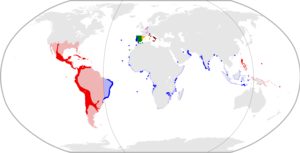Consejo de Indias

The Consejo de Indias ( Spanish Real y Supremo Consejo de Indias ; German for short India Council , more rarely West India Council ), was the highest colonial authority and the most important administrative body of the Spanish colonial empire . The Consejo de Indias governed all matters relating to Spain's overseas possessions in America and the Philippines . He was endowed with legislative and executive functions; in the colonies it was also the highest court of appeal . The Council initially did not own fixed seat, but always went there together, where the respective Monarch stayed until 1561 by Charles V in the palace in the Alcazar of Madrid was moved.
History of the Consejo de Indias
The Consejo de Indias came into being gradually, as the new overseas territories that were taken over for the Spanish crown increased and gained in importance for the Spanish motherland: As early as 1503, Isabella I. to found its own chamber of commerce, the Casa de Contratación , in order to subject trade with the colonies to greater control. At the same time, a separate commission was formed in the Privy Council , which was specifically devoted to questions of possessions in the New World ; as early as 1516 this was called the Consejo de Indias ("India Council"). This initially rather informal body was headed by the influential statesman and clergyman Juan Rodríguez de Fonseca , who in this way became Spain's first colonial minister and is considered the actual architect of the Spanish colonial administration.
Fonseca had helped organize the second, still enthusiastically welcomed trip of Christopher Columbus ; however, a deep enmity developed between the two personalities during this time. After the rather disappointing outcome of the subsequent trips and the chaotic conditions on the islands themselves (the hoped-for riches were not found; more and more Spaniards died in armed conflicts with the native inhabitants of the islands; rivalries and animosities between individual leaders led to tensions; around the promised wealth cheated believed colonists accused Columbus of abuse and nepotism, and finally sent Columbus 500 enslaved Tainos as a "gift" to his patroness Isabella, by the slavery continued, however, was over nothing and the Tainos sent back to their homeland as soon as possible), the Catholic Set up a commission of inquiry that included Fonseca. As a result, Fonseca advised the Spanish monarchs to submit all newly discovered areas directly to the crown and to withdraw the privileges previously granted to the discoverers - in this specific case, Christopher Columbus. Thus, in 1500, Francisco de Bobadilla, the first independent, fully empowered civil servant under the sole responsibility of the Crown, was sent to the New World, whose first task was to enforce the will of the monarchs of the motherland in the colonies. This laid the foundation for the later colonial administration. Columbus lost the titles of “viceroy” and “governor”, he was removed from office and finally transported back to Spain in chains.
When Charles I reformed the state and Hernán Cortés enormously enlarged the overseas possessions with the conquest of Mexico , the Consejo de Indias was converted into an independent institution in 1524 , which now bears the official name Real y Supremo Consejo de Indias .
The facility remained under this name until the 18th century. It was not until 1714 that is Consejo de Indias during the Bourbon administrative reforms , (Reformas borbonicas) stripped of its legislative and administrative tasks. In addition, from 1717 the institution lost more and more functions to the newly created Secretaría de Marina e Indias . The Consejo de Indias was abolished in 1812, but was reinstated two years later during the restoration of Ferdinand VII . The institution was not finally dissolved until 1834.
Organization and tasks
The Consejo de Indias was composed of a president, about twelve councilors and subordinate staff. The offices included u. a. a grand chancellor, a treasurer , two secretaries , a clerk , a cosmographer , a chronicler and a lawyer for the poor. Its members were predominantly lawyers , theologians or scholars of mostly bourgeois origin and were all appointed by the crown. He met weekly to report to the king on his activities; the recommendations made were then approved or rejected by the king.
The Consejo de Indias regulated all political, legal and administrative questions of the colonies. His various tasks ranged from the organization of settlement programs to the creation of viceroyalty to the monitoring of censorship .
In 1785 the documents of the Consejo de Indias were issued by royal decree of Charles III. transferred to the Archivo General de Indias in Seville , which was set up specifically for this purpose .
See also
literature
- Ernst Schäfer: The Royal. Spanish Supreme Council of India. Consejo real y supremo de las indias. Part 1: History and organization of the Council of India and the Casa de la Contratacion in the sixteenth century. Ibero-American Institute, Hamburg 1936.
Individual evidence
- ↑ El Consejo de Indias, el gobierno de la América Española. In: Historia del Nuevo Mundo. January 6, 2018, accessed June 29, 2020 (European Spanish).